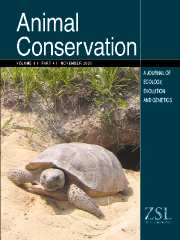Crossref Citations
This article has been cited by the following publications. This list is generated based on data provided by
Crossref.
Weishampel, John F.
Bagley, Dean A.
Ehrhart, Llewellyn M.
and
Rodenbeck, Brian L.
2003.
Spatiotemporal patterns of annual sea turtle nesting behaviors along an East Central Florida beach.
Biological Conservation,
Vol. 110,
Issue. 2,
p.
295.
Maros, Alexandra
Louveaux, Alain
Liot, Elodie
Marmet, Julie
and
Girondot, Marc
2005.
Identifying Characteristics ofScapteriscusspp. (Orthoptera: Gryllotalpidae) Apparent Predators of Marine Turtle Eggs.
Environmental Entomology,
Vol. 34,
Issue. 5,
p.
1063.
Rivalan, Philippe
Prévot-Julliard, Anne-Caroline
Choquet, Remi
Pradel, Roger
Jacquemin, Bertrand
and
Girondot, Marc
2005.
Trade-off between current reproductive effort and delay to next reproduction in the leatherback sea turtle.
Oecologia,
Vol. 145,
Issue. 4,
p.
564.
Maros, Alexandra
Louveaux, Alain
Liot, Elodie
Marmet, Julie
and
Girondot, Marc
2005.
Identifying Characteristics of <I>Scapteriscus</I> spp. (Orthoptera: Gryllotalpidae) Apparent Predators of Marine Turtle Eggs.
Environmental Entomology,
Vol. 34,
Issue. 5,
p.
1063.
Caut, S.
Hulin, V.
and
Girondot, M.
2006.
Impact of density‐dependent nest destruction on emergence success of Guianan leatherback turtles (Dermochelys coriacea).
Animal Conservation,
Vol. 9,
Issue. 2,
p.
189.
Mrosovsky, N.
2006.
Distorting Gene Pools by Conservation: Assessing the Case of Doomed Turtle Eggs.
Environmental Management,
Vol. 38,
Issue. 4,
p.
523.
Maros, Alexandra
Louveaux, Alain
Lelarge, Caroline
and
Girondot, Marc
2006.
Evidence of the exploitation of marine resource by the terrestrial insect Scapteriscus didactylus through stable isotope analyzes of its cuticle.
BMC Ecology,
Vol. 6,
Issue. 1,
Caut, Stéphane
Guirlet, Elodie
Jouquet, Pascal
and
Girondot, Marc
2006.
Influence of nest location and yolkless eggs on the hatching success of leatherback turtle clutches in French Guiana.
Canadian Journal of Zoology,
Vol. 84,
Issue. 6,
p.
908.
Gratiot, N.
Gratiot, J.
Kelle, L.
and
de Thoisy, B.
2006.
Estimation of the nesting season of marine turtles from incomplete data: statistical adjustment of a sinusoidal function.
Animal Conservation,
Vol. 9,
Issue. 1,
p.
95.
Rivalan, P.
Dutton, P.H.
Baudry, E.
Roden, S.E.
and
Girondot, M.
2006.
Demographic scenario inferred from genetic data in leatherback turtles nesting in French Guiana and Suriname.
Biological Conservation,
Vol. 130,
Issue. 1,
p.
1.
Richardson, J. I.
Hall, D. B.
Mason, P. A.
Andrews, K. M.
Bjorkland, R.
Cai, Y.
and
Bell, R.
2006.
Eighteen years of saturation tagging data reveal a significant increase in nesting hawksbill sea turtles (Eretmochelys imbricata) on Long Island, Antigua.
Animal Conservation,
Vol. 9,
Issue. 3,
p.
302.
Girondot, Marc
Godfrey, Matthew H.
Ponge, Laurent
and
Rivalan, Philippe
2007.
Modeling Approaches to Quantify Leatherback Nesting Trends in French Guiana and Suriname.
Chelonian Conservation and Biology,
Vol. 6,
Issue. 1,
p.
37.
Hilterman, Maartje L.
and
Goverse, Edo
2007.
Nesting and Nest Success of the Leatherback Turtle (Dermochelys coriacea) in Suriname, 1999–2005.
Chelonian Conservation and Biology,
Vol. 6,
Issue. 1,
p.
87.
Caut, Stéphane
Guirlet, Elodie
Angulo, Elena
Das, Krishna
Girondot, Marc
and
Somers, Michael
2008.
Isotope Analysis Reveals Foraging Area Dichotomy for Atlantic Leatherback Turtles.
PLoS ONE,
Vol. 3,
Issue. 3,
p.
e1845.
Jackson, Andrew L.
Broderick, Annette C.
Fuller, Wayne J.
Glen, Fiona
Ruxton, Graeme D.
and
Godley, Brendan J.
2008.
Sampling design and its effect on population monitoring: How much monitoring do turtles really need?.
Biological Conservation,
Vol. 141,
Issue. 12,
p.
2932.
Honarvar, Shaya
O’Connor, Michael P.
and
Spotila, James R.
2008.
Density-dependent effects on hatching success of the olive ridley turtle, Lepidochelys olivacea.
Oecologia,
Vol. 157,
Issue. 2,
p.
221.
Salvidio, Sebastiano
and
Oneto, Fabrizio
2008.
Density regulation in the Mediterranean leaf‐toed gecko Euleptes europaea.
Ecological Research,
Vol. 23,
Issue. 6,
p.
1051.
Patino-Martinez, Juan
Marco, Adolfo
Quiñones, Liliana
and
Godley, Brendan
2008.
Globally significant nesting of the leatherback turtle (Dermochelys coriacea) on the Caribbean coast of Colombia and Panama.
Biological Conservation,
Vol. 141,
Issue. 8,
p.
1982.
Fish, M.R.
Côté, I.M.
Horrocks, J.A.
Mulligan, B.
Watkinson, A.R.
and
Jones, A.P.
2008.
Construction setback regulations and sea-level rise: Mitigating sea turtle nesting beach loss.
Ocean & Coastal Management,
Vol. 51,
Issue. 4,
p.
330.
Fossette, Sabrina
Kelle, Laurent
Girondot, Marc
Goverse, Edo
Hilterman, Maartje L.
Verhage, Bas
de Thoisy, Benoît
and
Georges, Jean-Yves
2008.
The world's largest leatherback rookeries: A review of conservation-oriented research in French Guiana/Suriname and Gabon.
Journal of Experimental Marine Biology and Ecology,
Vol. 356,
Issue. 1-2,
p.
69.


